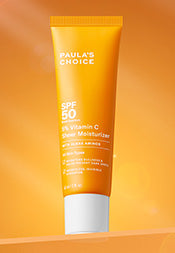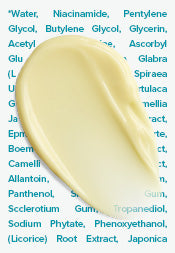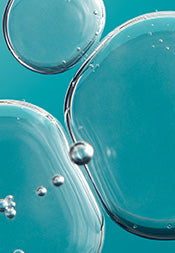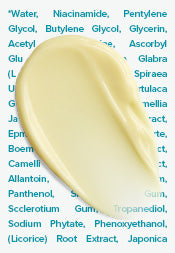Benefits of Panthenol or Pro-Vitamin B5 for Skin and Hair
Panthenol in skincare products, like facial cleansers, face creams, or moisturizers, is an often-overlooked cosmetic industry hero with loads of research backing its ability to improve the skin’s barrier strength and hydration, among other benefits. We’ll explain exactly what it is, why it works so well, what benefits you can expect to see, and how to incorporate it into your self-care routine.
What is panthenol?
Panthenol, also known as pro-vitamin B5, is a substance derived from the B vitamin pantothenic acid. While pantothenic acid itself occurs naturally in plant and animal (including human) tissues, the types of panthenol used in cosmetic formulations, like the ones in moisturizers and face creams, are synthetically produced.
Panthenol is water soluble and “plays well” with other ingredients, making it agreeable to formulate within skincare products. It’s also widely used in hair care formulations and can be found in makeup products, as well as oral supplements.
What is panthenol in skincare?
The panthenol that is commonly used in face creams comes in two forms: D-panthenol (a viscous oil, also known as dexapanthenol) and DL-panthenol (a white, crystalline powder) (1). Of these, D-panthenol has notably more research behind it and is described as the more bioactive form, meaning it’s more impactful. However, DL-panthenol is still considered beneficial (2). Both have their place in skincare thanks to their ability to amplify moisture and soothe skin.
What skin type is panthenol good for?
While any skin type can benefit from face creams that have panthenol, it’s especially beneficial for dry or dehydrated skin, as well as compromised skin. This pro-vitamin 5’s skin-softening and hydration-boosting properties form a powerhouse for improving a rough, dry face, leaving it feeling more supple and soothed.
Board-certified dermatologist, Dr. Corey L. Hartman adds, “Panthenol is a great way to fortify the epidermis and soothe a compromised skin barrier that is common in those with dry or dehydrated skin."
What does panthenol in face creams do for your skin?
Of note, studies emphasise panthenol’s effect on strengthening the skin barrier, thanks in part to its ability to reduce transepidermal water loss (which is a fancy way of saying it helps prevent moisture evaporation from skin) due to its humectant properties (3).
Adding to the benefits, cumulative research shows D-panthenol has significant repairing and soothing properties, making it incredibly beneficial for skin that has experienced visible impairment from stressors. It may also play a role in visibly reducing facial redness triggered by sensitivity (4).
Dr. Hartman further clarifies, “Panthenol soothes the and can help improve skin’s hydration. It has been shown to lessen the appearance of redness in the skin.”
Is pro-vitamin B5 safe?
Panthenol has a long history of safe use in skincare and other personal care products (2). Of note, it has been thoroughly studied and analysed by the Cosmetic Ingredient Review Expert Panel, with their most recent 2018 assessment deeming panthenol safe for the skin in present practices and use. Their report surveyed over 5,000 products using up to 5.3% concentrations of Panthenol (5).
Is pro-vitamin B5 safe for the skin during pregnancy?
While there are no known concerns about using panthenol topically during pregnancy, we always suggest checking with your physician to discuss the products you plan to use during gestation and breastfeeding. When referring to topical products used during pregnancy, The Journal of Clinical and Aesthetic Dermatology notes, “Panthenol is considered safe since it is one of the elements in the skin” (6).
How to use panthenol for skin
Panthenol can be found in many types of skincare products, which allows you to incorporate it into your routine in a variety of ways. Generally speaking, you’ll reap the most benefit from this pro-vitamin B5 when used in leave-on products such as moisturizers, face creams, serums, toners and body lotions where it has a longer amount of time to interact with skin. However, it can even be beneficial in rinse-off formulas, such as facial cleansers, where it lends a hydrating and skin-conditioning effect, making it perfect for those with dry, oily, or combination skin.
Proven to be gentle, soothing, and barrier-strengthening, panthenol can be used daily in your skincare and body care routines (7).
Can panthenol be used with vitamin C, retinol, or other active ingredients?
Panthenol can be used with vitamin C serums, retinol skincare, and other active ingredients. In fact, the pro-vitamin B5’s ability to soothe skin and increase hydration can even help skin respond better to these potent types of ingredients.
Can panthenol cause acne?
Panthenol hasn’t been shown to cause acne. In fact, its soothing properties may complement skincare for acne-prone skin. As with any skincare ingredient, the formulary base that this pro-vitamin B5 is incorporated into matters. If your skin is prone to breakouts, avoid panthenol products that come in heavy, occlusive, rich creams, as those may clog the pores on your face and exacerbate acne breakouts.
Does Panthenol clog pores?
Panthenol is not a pore-clogging ingredient in and of itself. If the panthenol product you choose comes in a very emollient and/or occlusive type of consistency, like some face creams, then that base formula can potentially clog pores. However, that would be due to the overall texture of the product—not the panthenol itself. Panthenol can be incorporated into lightweight hyaluronic acid serums and even liquid anti-ageing skincare products, where pore clogging isn’t a concern.
Is panthenol good for hair?
This pro-vitamin B5 is good for hair when used as a conditioning agent that serves to moisturize. It can help improve the softness, shine, and look of dry hair. Outside of traditional topical methods, D-panthenol has been studied for promoting the formation of stronger hair, although researchers note that additional independent clinical trials are needed to confirm the results (8,9).
How to use Panthenol for hair
Panthenol is commonly included in hair conditioners and other types of hair care/styling products — check your labels, and you might find that you’re already using it! If they don’t have the word panthenol exactly, check if they have pro-vitamin B5. No special usage instructions are required, just use the product as you normally would. For best results, look for leave-on products with panthenol since its water-soluble nature doesn’t allow much of it to cling to hair from rinse-out products.
Learn more about the skin-restoring ingredients we include in our skincare products.
Shop Paula’s Choice fragrance-free, non irritating skincare best sellers.
References for this information:
Cosmeticsinfo.org, Accessed May 2022, ePublication
Journal of Dermatological Treatment, May 2017, pages 776-773
Journal of Cosmetic Science, July/August 2011, pages 361-369
Pharmaceuticals, June 2020, pages 1-12
Cosmetic Ingredient Review, March 2018, pages 1-51
The Journal of Clinical and Aesthetic Dermatology, February 2022, pages 49-57
American Journal of Clinical Dermatology, August 2022, pages 427–433 (2002)
Current Issues in Molecular Biology, September 2021, pages 1,361-1,373
Journal of Cosmetic Dermatology, January 2020, pages 75-77











